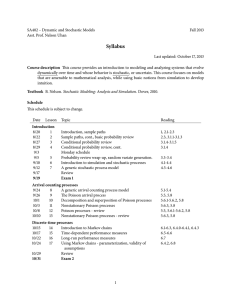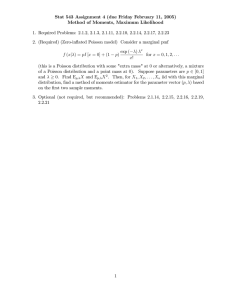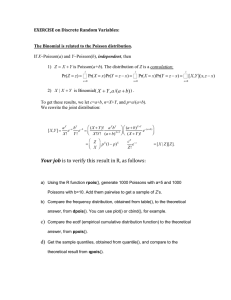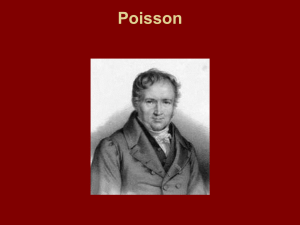SCIENCES COMM4UNICATION AND ENGINEERING
advertisement
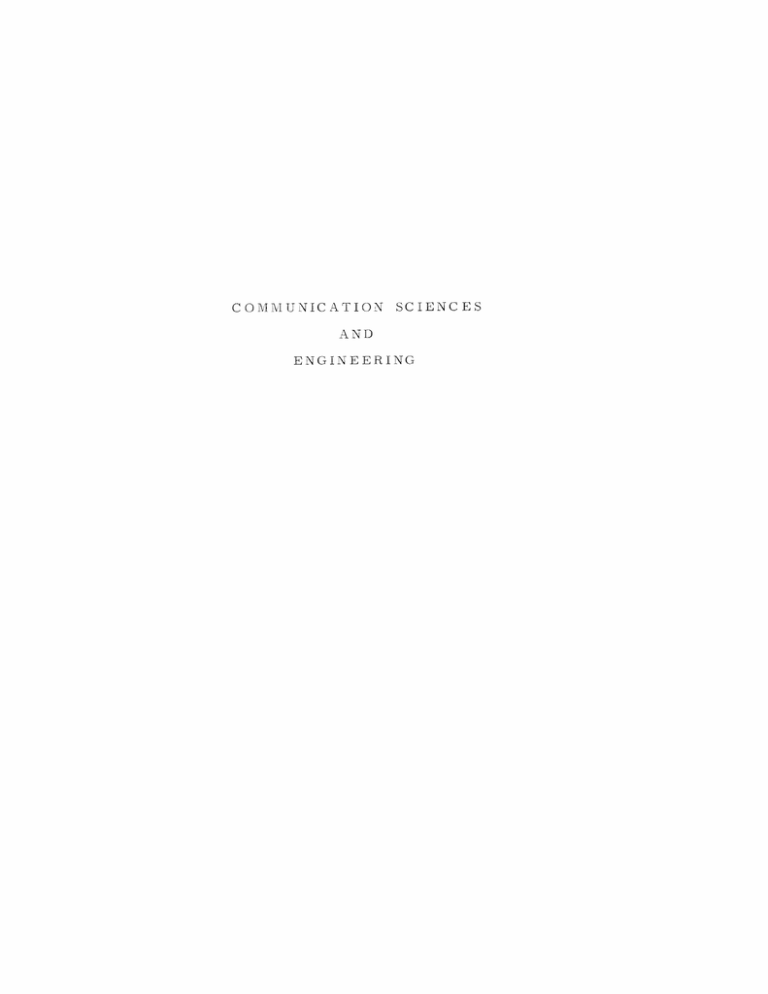
COMM4UNICATION
SCIENCES
AND
ENGINEERING
XVIII.
PROCESSING AND TRANSMISSION OF INFORMATION
Academic and Research Staff
Prof. P. Elias
Prof. R. G. Gallager
Prof. M. E. Hellman
Prof. E. V. Hoversten
Prof. R. S. Kennedy
Prof. C. E. Shannon
Graduate Students
P. Alexander
J. R. Clark
S. J. Dolinar, Jr.
J. C. Eachus
R. A. Flower
M. A. Freedman
J.
J.
B.
M.
G.
G.
E.
K.
J.
Q.
Himes
Just
Levitt
Marcus
McDowell
L.
P.
A.
B.
R.
T.
S. Metzger
F. Moulton
J. R. Muller
Neumann
S. Orr
A. Welch
RESEARCH OBJECTIVES AND SUMMARY OF RESEARCH
1.
Optical Communication
The fundamental limitations and efficient utilization of optical communication channels are the concern of these investigations. Our interests include the turbulent atmospheric channel, scattering channels, scatter channels with absorption, and quantum
channels. During the coming year our activities will focus on improving the understanding of scattering channels, on practical, or at least feasible, methods of implementing near optimum detection and estimation systems, and on imaging radar
systems.
The characteristics of scattering channels, such as clouds, fog, and haze, are
being investigated experimentally and theoretically. The broad purpose of these
investigations is tp develop the quantitative description of these channels so that
their utility for specific communication applications can be assessed. The studies
of scatter channels with absorption such as the ocean have a similar purpose. The
objective of one doctoral investigation is to relate the optical propagation characA second doctoral
teristics of the cloud to its gross physical characteristics.
investigation is concerned with efficient means of measuring those parameters of
The objectives
scattering channels that are important in communication applications.
are to draw upon theoretical considerations to develop efficient measuring techniques
and then to implement these techniques on the experimental scatter link that has
been developed in cooperation with Lincoln Laboratory, M. I. T.
Our understanding of quantum communication theory has continued to increase during
the past year. A general procedure for translating a classical description of a communication channel into a full quantum description was developed for linear channels. 3 In
addition to simplifying many steps in the development of a quantum model, the procedure
also avoids the need for an artificial representation for the system operators. In the
same study some new and important properties of optimum receivers were developed.3,4
The problems of communicating through the clear turbulent atmosphere will continue to receive attention during the coming year. The feasibility of implementing a
This work was supported principally by the National Aeronautics and Space Administration (Grant NGL 22-009-013), and in part by the Joint Services Electronics Program
(U.S. Army, U.S. Navy, and U.S. Air Force) under Contract DA 28-043-AMC-02536(E),
and the U. S. Army Research Office - Durham (Contract DAHCO4 -69 -C -0042).
QPR No. 100
143
(XVIII.
PROCESSING AND TRANSMISSION OF INFORMATION)
wavefront phase compensating receiver has been examined in an experimental thesis.5
An investigation of variable-rate, or burstlike, communications systems has been
completed.6 This study emphasized the performance gains that can be achieved on
an earth-to-space link. Both heterodyne and direct detection systems were considered.
Detector output statistics and error bounds for direct-detection receivers have been
considered and will receive further attention. 7 , 8 Two other atmospheric studies will
be completed during the coming year. One of these is concerned with the performance and structure of receivers that track, or adapt to, the instantaneous channel
state so as to make optimal use of the spatial diversity in the receiving aperture. The other is addressed to the structure and performance of waveform estimators
for Poisson processes.10 This work, which will consider both optimal and suboptimal
estimators, is directly applicable to analog communication systems that employ directdetection receivers.
R. S. Kennedy, E. V. Hoversten
2.
Coding for Noisy Channels
The goals of this work are: first, to develop fundamental limitations on data rate,
reliability, and system complexity for data transmission over noisy channels; and
second, to develop communication techniques that approach these limitations. One
of the most promising such techniques is that of convolutional coding and sequential
decoding. A new mathematical technique, called "branching random walks," is being
developed to simplify and extend the analysis of convolutional codes and sequential
decoding. In addition, two doctoral theses have recently been completed. The first
dealt with the feasibility of concatenated convolutional codes,11 and the second established basic limitations on mean-square error when transmitting analog samples
over white Gaussian noise channels without intersample coding. 1 2
R. G. Gallager
3.
Simple Encoding Techniques for Analog Signals
Two simple techniques for encoding analog sources continue to be explored: quantization and feedback. A paper has been published during the year on optimum multivariate quantizers. 1 3 Doctoral research by Bernd Neumann is directed toward
the use of noiseless feedback for communication over a forward channel with additive Gaussian noise which is not white, so that feedback increases channel capacity.
P. Elias
4.
Digital Data Networks and Other Data-Processing Problems
Digital data networks are of great and still growing importance, both in local networks like the one connecting several hundred terminals to several computers at M.I.T.
and in more widely dispersed systems. The possibility of buffering messages at inter-mediate nodes, of switching messages rather than lines, and of having networks in
which nodes are more expensive than branches, present new areas for research
which are now being defined with the help of several graduate students.
Information theory has relevance to other data-processing problems, and several
are being explored. Terry A. Welch has been pursuing a doctoral investigation in
information retrieval, relating the amount of information stored in a catalog to the
QPR No.
100
144
(XVIII.
PROCESSING AND TRANSMISSION OF INFORMATION)
relevance, recall, and retrieval effort involved in its use. Other work is under way
using informational analysis in the study of switching systems, sorting algorithms,
the storage and retrieval of simple information structures, and the generation of
independent equiprobable random digits from less random input data.
P. Elias
5.
Finite Memory-Learning Algorithms
The problem of testing among several hypotheses when the data must be summarized
by a finite-valued statistic is being studied. The large sample size problem has
been solved previously, 1 4 and promising results have been obtained for small sample
15
The differences between deterministic and stochastic algorithms are also
sizes.
being studied and substantial progress has been made in determining the properties
of both types.
16
18
M. E.
Hellman
References
1.
2.
3.
4.
5.
6.
7.
8.
9.
10.
11.
12.
13.
T. P. McGarty, "The Statistical Microstructure of Random Fields Generated by
Multiple Scatter Media" (see Section XLX-A).
P. A. Alexander, "Measurement of Dispersive Optical Communication Channels,"
Ph.D. thesis proposal, September 1970.
H. Yuen, "Communication Theory of Quantum Systems," Ph. D. Thesis, M. I. T.,
June 1970.
H. Yuen, R. Kennedy, and M. Lax, "On General Optimal Receiver Specification
in Digital Quantum Signal Detection," Proc. IEEE, October 1970.
G. Q. McDowell, "Pre-distortion of Local Oscillator Wavefront for Improved
Optical Heterodyne Detection through the Turbulent Atmosphere," Ph. D. Thesis
(to be submitted in 1971).
B. K. Levitt, "Variable-Rate Optical Communication through the Turbulent Atmosphere," Ph.D. Thesis (submitted December 1970).
J. R. Clark and E. V. Hoversten, "Poisson Processes as a Statistical Model for
Photodetectors Excited by Gaussian Light," Quarterly Progress Report No. 98,
Research Laboratory of Electronics, M. I. T. , July 15, 1970, pp. 95-101.
E. V. Hoversten, "On the Performance of Direct Detection Optical Communication
Systems for the Turbulent Atmosphere, " 1970 International Conference on Information Theory, Noordwijk, Netherlands, June 15-19, 1970.
R. S. Orr, "Channel Measurements Receiver for Optical Communication" (Thesis
Proposal, February 1970).
J. R. Clark, "Waveform Estimators for the Turbulent Atmospheric Optical Channel, " Quarterly Progress Report No. 97, Research Laboratory of Electronics,
M.I.T., April 15, 1970, pp. 105-112.
J. L. Ramsey, "Cascaded Tree Codes," Ph.D. Thesis, Department of Electrical
Engineering, M.I.T., June 1970.
D. L. Cohn, "Minimum Mean Square Error without Coding," Ph.D. Thesis,
Department of Electrical Engineering, June 1970.
P. Elias, "Bounds and Asymptotes for the Performance of Multivariate Quantizers,"
Ann. Math. Statist. 41, 1249-1259 (1970).
QPR No. 100
145
(XVIII.
PROCESSING AND TRANSMISSION OF INFORMATION)
14.
M. E. Hellman and T. M. Cover, "Learning with Finite Memory," Ann. Math.
Statist. 41, 765-782 (1970).
15.
R. Flower, "Hypothesis Testing with Finite Memory in Finite Time," S. M. Thesis,
Department of Electrical Engineering, M. I. T. , December 1970.
16.
M. E. Hellman and T. M. Cover, "On Memory Saved by Randomization" (to appear
in Ann. Math. Statist.).
17.
M. E. Hellman, "The Effects of Randomization on Finite Memory Decision Algorithms, " 1970 IEEE Symposium on Adaptive Processes, Austin, Texas, December 7-9, 1970.
18.
J. A. Horos, "Deterministic Learning Algorithms Using Finite Memory, S. M.
Thesis, Department of Electrical Engineering, M. I. T. , December 1970.
A.
ESTIMATION FOR POISSON PROCESSES
In this report we present some new results in the theory of minimum mean-square
error estimation for Poisson processes.
be presented here,
PrQofs of the theorems,
too involved to
will be given elsewhere.
It is well known that the minimum mean-square error (MMSE) estimate of a
random variable z relative to a data set {y., - E [to, t ] } is simply the conditional
expectation E{z yU, 0-E [t o , t]}. Straightforward calculation of this quantity is usually
a prohibitively difficult task.
Using indirect methods, we have obtained a useful repre-
sentation for the conditional mean when
process; that is,
(y,
-E
[t o , t]} is a doubly stochastic Poisson
when the data process is a counting process with a stochastic rate
function such that {y, a- E [t o , t]} is conditionally Poisson. 1 - 3
Theorem 1
Let {N t
E T= [t o
be a doubly stochastic vector Poisson process with conditionally independent components. Assume that the vector rate process {Xt , t
T} of
t
t l ]}
{N t , t
T} is non-negative a. s. and integrable. Let z be a vector random variable
with components in L 2, such that z is measurable with respect to B ', the Borel
field generated by {(
tic differential
t
,0- E [t o0 ,t]}.
Define
the process
{vt, tE T} by the stochasA
A
equation dvt = dNt - Xtdt, where Xt = E{(tlBN }.
Finally, let
-
t
A
At be
Then
a diagonal
matrix
with nonzero
entries,
the
components
A
of the vector Xt.
(i)
BN-
(ii)
the conditional mean At = E(z BNt ), t eT) can be represented by the stochastic
B,
all tE
T;
integral equation,
QPR No. 100
146
(XVIII.
+t
+
A
A
z = z
E z(
-
PROCESSING AND TRANSMISSION OF INFORMATION)
A )(-11
)'k BG
A
(1)
dv ,
to
0
0
where prime indicates transpose.
4
This result is in the spirit of recent work of Frost for Gaussian processes, and
has wide applicability in problems of filtering, parameter estimation, prediction,
smoothing, and detection.
detail in references 5-8.
Stochastic integrals such as that in (1) are discussed in
A
The significance of this theorem is that z t is expressed as an explicit functional
of the observations. Thus stochastic differential equations can be derived with ease
for many estimators of interest. Consider the second-order vector Ito process
,
defined by dxt = ftdt + gtdit where {t, t E T} is an independent increment
martingale, and (ft, tE T} and {gt, t E T} are processes depending on xt and obeying
mild regularity conditions. Assume that Xt is a causal functional of xt. Using (1),
x t , t E T),
- E{xt
limit of E{xt+tjBN +A
and taking the
IB N t
) as At - 0, we get the
filtering equation,
dx
= ftdt + Ex
t(Xt-kt)'
B V }t
(2)
dv t
suppose we wish to estimate the scalar process
yt = exp(iv'xt), t E T). By a similar argument, we find that the conditional characteristic function yt satisfies the Ito equation
As another filtering example,
dy = Et(v)
}
exp(iv'xt) 1B
A t dvt ,
dt + E{((Xt-Xt)'exp(iv'x t) B V
where 4it(v) is the characteristic form of the differential generator
ýt(v) = p lim At
At-O
- 1
E {exp[iv'(x t+t-xt)]-I Bt U B
t
}.
(3)
of x t ,
(4)
t
I
This "canonical filtering theorem" was obtained by Snyder by different means. Note
that Yt is a sufficient statistic for At relative to {N , ~E [t o , t]}.
As an example of noncausal MMSE filtering, let us estimate xt based on data
up to time
T
> t.
S
E{xtIBN
From our representation theorem we have
= Ex BN
+
Ex(
-( )' 1B
-1
dv
.
(5)
Note that this is the sum of two orthogonal estimates because the stochastic integral
is a martingale in its upper limit; the first term is the causal filtered estimate,
QPR No. 100
147
(XVIII.
PROCESSING AND TRANSMISSION OF INFORMATION)
and the second is an estimate
"backward in time"
7.
of x t given data up to time
This backward estimate is causal relative to a reversed time scale.
By using (5)
it is easy to verify the intuitive notion that the causal mean-square error must be
greater than the noncausal mean-square error.10
We now consider a simple example of MMSE
intensity of N t be akt + Xo,
process,
with a a zero-one random variable,
and Xk a non-negative constant.
A
t
=
A-
AA
t } tA t
E a(aX -at')B
t
= E {t
,av 1,
B
AA
ponents of ak
ft
Xt a non-negative
Since
(2) applies to give
dv t ,
(6)
A
A
where
1
Let the
Let us estimate the parameter a.
a is an Ito process (albeit somewhat degenerate),
da
parameter estimation.
t
+ Xo.
and At is a diagonal matrix with nonzero entries,
the com-
This can be solved explicitly by making the change of variable
Omit the details, and the end result of this is
= In ( at/1-at).
D
x'e.
d1 =
t-ee.j + In 1 +
dNe. ,
j=1 I-
or in integral form,
D
S+
tA
-
0
t 0t
e d--+
t
F
In 1 +r
L_
0
dN ej
The observation vector Nt is assumed to be D-dimensional,
D
unit vectors in R
(7)
and {ej. is the set of
This simple example of MMSE parameter estimation is significant because it
is the log-likelihood ratio for deciding between the hypotheses
H1:
rate process of N t is X + Xo
t
Ho:
rate process of Nt is k ;
based on the observations
makes this apparent.
ft
N,_, o E [t o
t ]j.
The fact that
t = E a BNt
= Pra
=II
BNt
is the a priori log-likelihood ratio In [Pr(a = 1)/Pr (a=0)].
A O
It should be noted that
t = E{XtIB
, a= 1} has an interpretation as an MMSE causal
t
estimate only when a = 1.
Equation 7 is the extension of the well-known Reiffen-Sherman detector11 to stochastic
intensity functions and vector observations.
QPR No. 100
148
In scalar form it is identical to the result
(XVIII.
PROCESSING AND TRANSMISSION OF INFORMATION)
obtained by Synder
under somewhat more restrictive assumptions.
sion of (7) was also obtained by Evans 1 2 using different methods.
Other applications of the representation theorem, Eq.
The scalar ver-
1, will be considered in
detail elsewhere.
We now state an interesting result that provides a link between doubly stochastic
Poisson process characterization and MMSE estimation.
The conditional joint proba-
bility density function of the number of events N t in (to ,t], and the event times r,
of a doubly stochastic scalar Poisson process with rate function Xt, is given by
N
p({T },Nt IB)
=
exp
11
1x
d]
•_
i
(8)
This can be written in the form
exp
X dg + f
-t
In X dN},
o
o
where the second integral is a stochastic integral.
By using techniques of the stochastic
calculus and properties of conditional expectation,
this can be averaged over
all
possible sample paths of (XX,a E [to , t]} to yield the following theorem.
Theorem 2
N
p({T}, N t ) = exp j
t
L
t
A
where Xt = EXt IBN ), and
t
Ti'
A
t_=
(9)
]N XA
d
d-
0
A
lim
A
0
X•
A
This result, which is identical in form to Eq. 8, has far-reaching implications. It
provides a closed-form representation for doubly stochastic Poisson processes, which
can serve as the basis for the design of detectors and demodulators for random
signals.
The detection equation,
(7),
can be derived immediately from the vector
version of (9),
as can likelihood ratios for other hypotheses.
The form in which
A
(9) is written is somewhat misleading, since Xt depends implicitly on ITj} and N.
Nevertheless,
that p({Tj, N t) can be written so simply and succinctly is pro-
pitious.
We have presented two theorems that provide powerful tools for the design of
systems using doubly stochastic Poisson processes.
Proofs and other applications
will be given elsewhere.
J. R. Clark
QPR No. 100
149
(XVIII.
PROCESSING AND TRANSMISSION OF INFORMATION)
References
I.
2.
3.
4.
5.
6.
7.
8.
9.
10.
11.
D. L. Snyder, "Filtering and Detection for Doubly Stochastic Poisson Processes"
(to appear in IEEE Trans. on Information Theory).
D. R. Cox and P. A. W. Lewis, The Statistical Analysis of Series of Events
(Methuen, London, 1966), Chap. 7.
M. S. Bartlett, Stochastic Processes (Cambridge University Press, London,
1966), p. 325.
P. A. Frost, "Nonlinear Estimation in Continuous -Time Systems," Ph.D. Thesis,
Stanford University, 1968.
J. L. Doob, Stochastic Processes (John Wiley and Sons, Inc.,
Chap. IX.
P. Meyer, Ill. J. Math. 6, 193-205 (1962).
New York, 1953),
P. Meyer, Ill. J. Math. 7, 1-17 (1963).
I. I. Gikhman and A. V. Skorokhod, Introduction to the Theory of Random Processes (Saunders, Philadelphia, 1969).
A. V. Skorokhod, Studies in the Theory of Random Processes (Addison-Wesley
Press, New York, 1965), p. 81.
J. R. Clark, "Estimation for Poisson Processes, with Applications in Optical
Communication," Ph. D. thesis proposal, Department of Electrical Engineering,
M.I.T., December 1970.
B. Reiffen and H. Sherman, Proc. IEEE 51, pp. 1316-1320 (1963).
14.
J. Evans, Quarterly Progress Report No. 98, Research Laboratory of Electronics,
M.I.T., July 15, 1970, p. 103.
I. Bar-David, IEEE Trans., Vol. IT-15, pp. 31-37, January 1969.
E Parzen, Stochastic Processes (Holden-Day, San Fransisco, 1962), Chap. 4.
B.
PHOTOCOUNT STATISTICS:
1.
Introduction
12.
13.
A REPRESENTATION THEOREM
Calculation of the photocount distributions arising from the incidence of a random
optical field upon an ideal photodetector can be difficult if attempted by direct methods.
In this report we show how judicious application of a representation theorem using
Poisson functions succeeds, in some cases, in reformulating the calculation into
the determination of a linear transformation that maps a given photocount distribution into the actual photodetector output distribution.
2.
Poisson Expansions
Consider functions x(
xnp n(u);
x(u) =
.)
which may be represented as follows:
(1)
uE[0, C)
n=0
QPR No. 100
150
(XVIII.
where pn (
)
PROCESSING AND TRANSMISSION OF INFORIMATION)
represents the nth Poisson function
n
pn( ) =
n = 0, 1, ....
uE [0, 1);
eU;
(2)
The Poisson functions are the probabilities associated with a Poisson random variable n
of mean n = u.
In order to find the expansion coefficients {Xn} associated with x( ) we may note
that the Taylor series (if it exists) for eUx(u) is
oc
n
(3)
x u
e x(u)
n n!
n=0
Using the Taylor inversion formula, we find
dn
(4)
d [eux(u)]uu=
xn = dun
which, by Leibnitz' rule for product differentiation, is
n
(nk
xn =
k=0
n
du
(5)
x(u)
u=0
In the rest of the report Poisson expansions are used to calculate photocount statistics.
3.
Reception in the Presence of Fading
The random process resulting from the incidence of a random field on an ideal pho1
If the rantodetector has been characterized as a doubly stochastic Poisson process.
domness of the received field arises solely from a constant multiplicative fading in
intensity, then the resulting conditional counting statistics are given by
Pr
(6)
(# counts = ma)}= pm(au),
where u is the nominal average number of counts, and a, the intensity fading, is a
random variable with density q( ). We wish to examine the unconditional counting
statistics
Pr
(# counts = m}
gm(u) =
pm(au) q(a) da.
Suppose gm(u) has a Poisson expansion for non-negative m:
QPR No. 100
151
(7)
PROCESSING AND TRANSMISSION OF INFORMATION)
(XVIII.
00
(8)
rmnpn(u).
gmm(u) = I
n=0
Formula (5) may be applied to find r mn . After considerable algebraic manipulation
we find that the expansion coefficients are expressible as a simple function of the
moments of the fading variable:
am(1-a)nm;
n
m
rmn
mn
(9)
0;
n <m
That is,
(=m
g(u)
am(l-a)-m
(10)
n(u)
n=m
One may interpret this result as a linear transformation R:p(u) - g(u),
go(u)
Po(u)
p(u) =
where
1(u)
g(u) =
(11)
1(u)
R is then represented by the infinite matrix R = {rmn},
and the result is written
(12)
p(u) = R g(u).
An immediate generalization of (12) is obtained by noting that since the elements
of R depend only upon moments of the fading variable a, and not on the "signal
intensity" u, then u may be treated as a random variable and (12) may be averaged
over u to yield
_u
p(u)
u_
=
R g(u)
(13)
This may be regarded as an expansion in terms
of the counting statistics for ran-
dom u without fading; viewed in this light the interesting facet is that the linear
transformation remains unchanged when random source intensity is introduced. One
may prefer to interpret (13) as a rule for performing expansions over basis sets
other than Poisson. If one can obtain the basis set by averaging the Poisson functions,
QPR No.
100
152
(XVIII.
PROCESSING AND TRANSMISSION OF INFORMATION)
then the transformation matrix (9) yields the correct expansion.
4.
Reception in the Presence of Fading and Additive Noise
Consider the case in which a single-mode received signal consists of a faded
replica plus a white Gaussian noise sample. The intensity in that received signal
is proportional to
au + n 2 , where a and u are as before and n is a circular complex Gaussian random variable with zero mean, and
counts is
m (u ) =
t
+ n12m e -au +n 2
n 2 = X.
The probability of m
a, n
(14)
,,ilI
ine average over n yielas
gm
where L
(u )
m
1
m
{
(x) =
au
au
1l+
L
(15)
X
k(I+X)
th Laguerre
polynomial
m
L
e
11( + + 1+m
() is the m
--
(-x)k
(16)
(k / k!
k=0
Using the series (16) in (15),
we obtain
m
g (u) = (l
m
(+)m
It is
au
(].
m+l
e
u]
q(a) da.
(17)
j=0
easy to show that in the limit X -
derived for the noiseless case.
0 (17)
becomes identical to (7),
which was
Again assume that gm(u) has a Poisson expansion
of the form (8) and apply the coefficient rule (5) to it. Then we find that
min (m, k)
m
(
rmnx)=
m+k+1l
n\
1 +)
(-a)
j=0
k=O
Equation 18 is difficult to simplify,
but the asymptotic behavior for small X can
be found via a Taylor series in X for r mn (X):
QPR No. 100
m
j I jn) m- (-1)j.
153
(XVIII.
PROCESSING AND TRANSMISSION OF INFORLMATION)
(m)an
m ,n
rm-n;
(I-a)n + X[na(l-a)n-1 -(l-a)n];
m = 0,
(19a)
n > 1
(19b)
mn
n
+(
m(l-a)n-m
am(1-a)
-
n
m
m-' (1-a) n(-m -1
m
n-
-(n)a
m+1a)
+ (2m+1) aml(1-a)n-m + (n-m) am+1(1-a)n-m-1 ;
In the limit X = 0 (19)
5.
n> m > 0
(19c)
agrees with (9).
Comparison with Previous Results
3
have used a different method to solve these same problems. For
the noiseless case they express the linear operator R as
Solimeno, et al.
(20)
R = f p(X) e 2(I+O) dX,
d
where O stands for the linear differential operator u yu,
I is the identity operator,
) is the probability density of the logarithm of the fading amplitude X=ln-a.
(I+O) can be represented as an infinite matrix over the Poisson basis and then R
calculated by a matrLx exponentiation and average over X. The last manipulations
are not carried out explicitly by Solimeno, but they may be done by using a Cauchy
4
and p(
integral theorem for functions of an operator
f(r) =
1
£-1
2nj
C
f(s)(sI-T)-
F
in Hilbert space
(21)
ds,
where C is an appropriate contour in the complex s -plane.
e
Xm
(l -e 2x n-m
The result is
n>m
(22)
r mn = [0 ;
n<m
0;
=
Equivalence of the noisy result
which agrees with (9) under the substitution X In \a.
(18) and Solimeno's comparable formula has not yet been demonstrated.
6.
Applications
It has been argued,
QPR No. 100
with justification,
154
that the output statistics
of an ideal
(XVIII.
PROCESSING AND TRANSMISSION OF INFORMATION)
photodetector excited by a signal plus independent background noise can be modelled
by a Poisson process. Clark and Hoversten 5 have investigated the validity of this
assumption from the point of view of cumulant comparison of counting statistics.
The techniques outlined in this report might be used to yield an alternative measure of
"Poisson-ness" in terms of an L 1 or L 2 norm of the transformation (R-I).
investigations are,
Such
at present, under way.
R. S. Orr
References
1.
D. R. Cox and P. A. W. Lewis, The Statistical Analysis of Series of Events (John
Wiley and Sons, Inc., New York, 1966), p. 179.
2.
S. Karp and J. R. Clark, "Photon Counting: A Problem in Classical Noise Theory,"
IEEE Trans., Vol. IT-16, No. 6, p. 676, 1970.
S. Solimeno, E. Corti, and B. Nicoletti, "Optical Communication in Turbulent
Media," J. Opt. Soc. Am. 60, 1245 (1970).
3.
4.
N. Dunford and J. T. Schwartz, Linear Operators Part I: General Theory (Interscience Publishers, Inc., New York, 1964).
5.
J. R. Clark and E. V. Hoversten, "Poisson Process as a Statistical Model for
Photodetectors Excited by Gaussian Light," Quarterly Progress Report No. 98,
Research Laboratory of Electronics, M. I. T., July 15, 1970, pp. 95-101.
QPR No. 100
155
